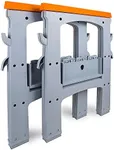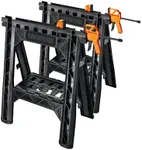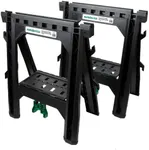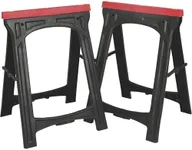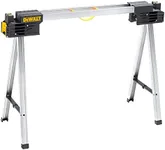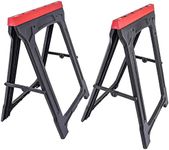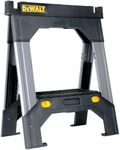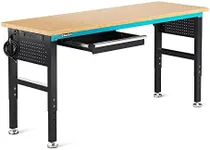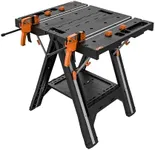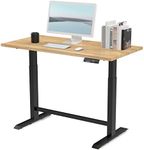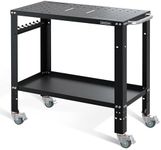Buying Guide for the Best Plastic Saw Horses
When it comes to choosing plastic saw horses, it's important to consider a few key specifications to ensure you get the right product for your needs. Saw horses are versatile tools that can be used for a variety of tasks, from supporting wood for cutting to serving as makeshift workbenches. The right saw horse will be sturdy, durable, and suitable for the type of work you plan to do. Here are some key specifications to consider when selecting plastic saw horses.Weight CapacityWeight capacity refers to the maximum amount of weight that the saw horse can support. This is important because it determines how much load the saw horse can handle without collapsing or becoming unstable. Weight capacities can range from a few hundred pounds to over a thousand pounds. For light-duty tasks, a saw horse with a lower weight capacity (around 300-500 pounds) may be sufficient. For heavier tasks, such as supporting large pieces of lumber or heavy equipment, look for saw horses with higher weight capacities (600 pounds and above). Consider the type of projects you will be working on and choose a weight capacity that matches your needs.
HeightThe height of a saw horse is the distance from the ground to the top of the saw horse. This is important because it affects your working comfort and the ergonomics of your tasks. Saw horses typically come in fixed or adjustable heights. Fixed-height saw horses are usually around 30 inches tall, which is a standard working height for many tasks. Adjustable-height saw horses allow you to customize the height to suit different projects and personal preferences. If you plan to use the saw horse for various tasks or if multiple people will be using it, an adjustable-height model may be more versatile and comfortable.
Material QualityMaterial quality refers to the type of plastic used in the construction of the saw horse. This is important because it affects the durability and longevity of the product. High-quality plastics, such as high-density polyethylene (HDPE), are more resistant to impact, weather, and wear and tear. Lower-quality plastics may be more prone to cracking or breaking under heavy use. When choosing a saw horse, look for one made from durable, high-quality plastic to ensure it can withstand the demands of your projects and last for a long time.
PortabilityPortability refers to how easy it is to move and transport the saw horse. This is important if you need to frequently move the saw horse between different job sites or storage locations. Features that enhance portability include lightweight construction, foldable design, and built-in handles. Lightweight saw horses are easier to carry, while foldable models can be compactly stored and transported. If you need a saw horse that is easy to move around, look for one with these portability features.
StabilityStability refers to how steady and secure the saw horse is when in use. This is important for safety and precision in your work. A stable saw horse will have a wide base, non-slip feet, and a sturdy construction that prevents wobbling or tipping. Some saw horses also have cross braces or locking mechanisms to enhance stability. When choosing a saw horse, consider the stability features to ensure it provides a secure and reliable platform for your tasks.
Additional FeaturesAdditional features refer to any extra functionalities or accessories that come with the saw horse. These can include built-in rulers, clamps, tool storage, or support arms for holding materials. These features can enhance the versatility and convenience of the saw horse, making it more useful for a variety of tasks. When selecting a saw horse, think about any additional features that might be beneficial for your specific needs and projects.
